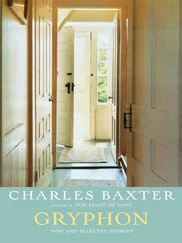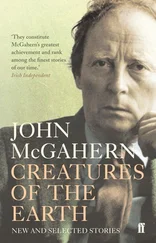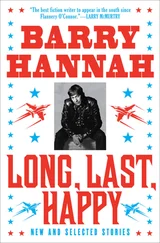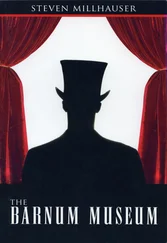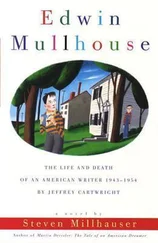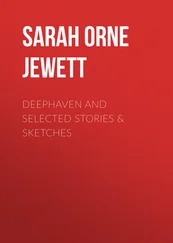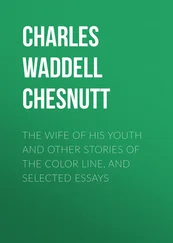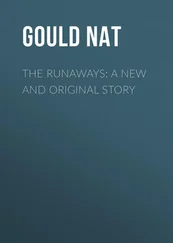The cat is pacing angrily in the kitchen, his hands behind his back and his eyebrows drawn down in a V. In a bubble above his head a wish appears: he is operating a circular saw that moves slowly, with high whining sounds, along a yellow board. At the end of the board is the mouse, lying on his back, tied down with ropes. The image vanishes and is replaced by another: the cat, wearing an engineer’s hat, is driving a great train along a track. The mouse is stretched across the middle of the track, his wrists fastened to one rail and his ankles to the other. Sweat bursts in big drops from the mouse’s face as the image vanishes and is replaced by another: the cat is turning a winch that slowly lowers an anvil toward the mouse, who is tied to a little chair. The mouse looks up in terror. Suddenly the cat lets go of the crank and the anvil rushes down with a whistling sound as the winch spins wildly. At the last moment, the mouse tumbles away. The anvil falls through the bubble onto the cat’s head.
The cat understands that the mouse will always outwit him, but this tormenting knowledge serves only to inflame his desire to catch the mouse. He will never give up. His life, in relation to the mouse, is one long failure, a monotonous succession of unspeakable humiliations; his unhappiness is relieved only by moments of delusional hope, during which he believes, despite doubts supported by a lifetime of bitter experience, that at last he will succeed. Although he knows that he will never catch the mouse, who will forever escape into his mousehole a half inch ahead of the reaching claw, he also knows that only if he catches the mouse will his wretched life be justified. He will be transformed. Is it therefore his own life that he seeks, when he lies awake plotting against the mouse? Is it, when all is said and done, himself that he is chasing? The cat frowns and scratches his nose.
The cat stands before the mousehole holding in one hand a piece of white chalk. On the blue wall he draws the outline of a large door. The mousehole is at the bottom of the door. He draws the circle of a doorknob and opens the door. He steps into a black room. At the end of the room stands the mouse with a piece of chalk. The mouse draws a white mousehole on the wall and steps through. The cat kneels down and peers into the mousehole. He stands up and draws another door. He opens the door and steps into another black room. At the end of the room stands the mouse, who draws another mousehole and steps through. The cat draws another door, the mouse draws another mousehole. Faster and faster they draw: door, hole, door, hole, door. At the end of the last room, the mouse draws on the wall a white stick of dynamite. He draws a white match, which he takes in his hand and strikes against the wall. He lights the dynamite and hands it to the cat. The cat looks at the white outline of the dynamite. He offers it to the mouse. The mouse shakes his head. The cat points to himself and raises his eyebrows. The mouse nods. The stick of dynamite explodes.
The cat enters on the left, wearing a yellow hard hat and pushing a red wheelbarrow. The wheelbarrow is piled high with boards. In front of the mousehole, the cat puts down the handles of the barrow, pulls a hammer and saw from the pile of boards, and thrusts a fistful of black nails between his teeth. He begins sawing and hammering rapidly, moving from one end of the room to the other as a cloud of dust conceals his work. Suddenly the dust clears and the cat beholds his creation: he has constructed a tall guillotine, connected to the mousehole by a stairway. The blue-black glistening blade hangs between posts high above the opening for the head. Directly below the opening, on the other side, stands a basket. On the rim of the basket the cat places a wedge of cheese. The cat loops a piece of string onto a lever in the side of the guillotine and fastens the other end of the string to the wedge of cheese. Then he tiptoes away with hunched shoulders and vanishes behind a fire shovel. A moment later, the mouse climbs the stairs onto the platform of the guillotine. He stands with his hands in the pockets of his robe and contemplates the blade, the opening for the head, and the piece of cheese. He removes from one pocket a yellow package with a red bow. He leans over the edge of the platform and slips the loop from the lever. He thrusts his head through the head hole, removes the piece of cheese from the rim of the basket, and sets the package in its place. He ties the string to the package, slides his head back through the hole, and fits the loop of the string back over the lever. From his pocket he removes a large pair of scissors, which he lays on the platform. He next removes a length of rope, which he fastens to the lever so that the rope hangs nearly to the floor. On the floor he stands cross-ankled against the wheel of the barrow, eating his cheese. A moment later, the cat leaps onto the platform. He looks up in surprise at the unfallen blade. He crouches down, peers through the head hole, and sees the yellow package. He frowns. He looks up at the blade. He looks at the yellow package. Gingerly he reaches a paw through the opening and snatches it back. He frowns at the string. A cunning look comes into his eyes. He notices the pair of scissors, picks them up, and cuts the string. He waits, but nothing happens. Eagerly he thrusts his head through the opening and reaches for the package. The mouse, eating his cheese with one hand, lazily tugs at the rope with the other. The blade rushes down with the sound of a roaring train; a forlorn whistle blows. The cat tries to pull his head out of the hole. The blade slices off the top half of his head, which drops into the basket and rolls noisily around like a coin. The cat pulls himself out of the hole and stumbles about until he falls over the edge of the platform into the basket. He seizes the top of his head and puts it on like a hat. It is backward. He straightens it with a half turn. In his hand he sees with surprise the yellow package with the red bow. Frowning, he unties it. Inside is a bright red stick of dynamite with a sizzling fuse. The cat looks at the dynamite and turns his head to the audience. He blinks once. The dynamite explodes. When the smoke clears, the cat’s face is black. In each eye a ship cracks in half and slowly sinks in the water.
The mouse is sitting in his chair with his feet on the hassock and his open book facedown on his lap. A mood of melancholy has invaded him, as if the brown tones of his room had seeped into his brain. He feels stale and out of sorts: he moves within the narrow compass of his mind, utterly devoid of fresh ideas. Is he perhaps too much alone? He thinks of the cat and wonders whether there is some dim and distant possibility of a connection, perhaps a companionship. Is it possible that they might become friends? Perhaps he could teach the cat to appreciate the things of the mind, and learn from the cat to enjoy life’s simpler pleasures. Perhaps the cat, too, feels an occasional sting of loneliness. Haven’t they much in common, after all? Both are bachelors, indoor sorts, who enjoy the comforts of a cozy domesticity; both are secretive; both take pleasure in plots and schemes. The more the mouse pursues this line of thought, the more it seems to him that the cat is a large, soft mouse. He imagines the cat with mouse ears and gentle mouse paws, wearing a white bib, sitting across from him at the kitchen table, lifting to his mouth a fork at the end of which is a piece of cheese.
The cat enters from the right with a chalkboard eraser in one hand. He goes over to the mousehole, bends down, and erases it. He stands up and erases the wall, revealing the mouse’s home. The mouse is sitting in his chair with his feet on the hassock and his open book facedown on his lap. The cat bends over and erases the book. The mouse looks up in irritation. The cat erases the mouse’s chair. He erases the hassock. He erases the entire room. He tosses the eraser over his shoulder. Now there is nothing left in the world except the cat and the mouse. The cat snatches him up in a fist. The cat’s red tongue slides over glistening teeth sharp as ice picks. Here and there, over a tooth, a bright star expands and contracts. The cat opens his jaws wider, closes his eyes, and hesitates. The death of the mouse is desirable in every way, but will life without him really be pleasurable? Will the mouse’s absence satisfy him entirely? Is it conceivable that he may miss the mouse, from time to time? Is it possible that he needs the mouse, in some disturbing way?
Читать дальше


